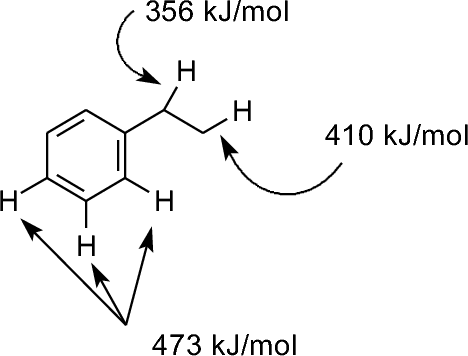| |
CH334Organic Chemistry
|
 |
| |
||
| |
||
| |
||
| |
I'd like us to consider initially a complex reaction: free-radical bromination of ethylbenzene (Problem 4-46g).  We'd like to know what product, or products, will form; more generally, we'd like to know why one or some products form but others do not. There are thousands or maybe even millions of similar transformations we might consider doing; few of them have been tried yet, and so we'd like a predictive model that can tell us the likely outcome. Understanding aspects of the reaction mechanism will allow us to do this. A mechanism is a specific set of bond-breaking and bond-forming processes that lead from reactants to products. All chemical reactions involve breaking at least one bond and forming at least one new bond; usually more than one may be be involved. So we have to propose a logical order for these reorganizations to occur that encompasses known systematic behavior of a wide array of organic and other molecules. The outcome should consistently predict the observed outcome. In this case, a simple place to start is to ask: what bonds are broken?
Br2 → 2 Br· The equilibrium for this lies far to the left; at 80°C this works out to 1 part in 1014 that gets converted to radicals. But remember that even a millimole has 6 x 1023 particles, so in a millimole of bromine at 80°C there will be millions of bromine atoms present. The bromine atoms that form have unpaired electrons: any such specied is called a free radical. Because of the absence of an octet free radicals are highly reactive. It can engage in an atom-transfer reaction, pulling an electron out of a covalent bond and taking one of the atoms with it. Hydrogens are easy to get to in ethylbenzene, but they will differ in how easy they are to pull off. We can judge this by the different bond-dissociation enthalpies:  We can then predict selectivity based on the cost of pulling off a hydrogen atom, less the enthalpic gain of forming H-Br (368 kJ/mol): CH3: +410 kJ/mol - 368 kJ/mol = +42 kJ/mol CH2: +356 kJ/mol - 368 kJ/mol = -12 kJ/mol Aromatic C-H: +473 kJ/mol - 368 kJ/mol = +105 kJ/mol The only reaction that is enthalpically favored is abstraction of the CH2 hydrogen! So we predict that this will be favored. Now, just because the initial reaction is uphill does not mean it cannot occur at all; if we get back more energy then we'd be OK. let's figure out where to go next. We have, at this stage:
 The energetics are the energy of the new bond, less the energy of the broken bond: C-Br = 293 kJ/mol Br-Br = 192 kJ/mol Net enthalpy change: -101 kJ/mol. When we combine this, we get the following: Substitute CH3 hydrogen: Net ΔH°= +42 kJ/mol -101 kJ/mol = -59 kJ/mol. This is possible. Substitute CH2 hydrogen: Net ΔH° = -12 kJ/mol - 101 kJ/mol = -113 kJ/mol. This is the best reaction energetically. Substitute an aromatic C-H: Net ΔH° = +105 kJ/mol - 101 kJ/mol = +4 kJ/mol; this is energetically uphill and will not happen. Note also: we generate the same species (a Br atom) that was used to start the process: this can react with anothe ethylbenzene molecule and so forth. It is very unlikely that it will recombine with another radical; remember only one part in 1014 of the system is present as a free radical. The observed outcome was reported in 1937 to give exclusively (1-bromoethyl)benzene, the CH2 substitution product, although photolytic initiation was used rather than thermal initiation. |